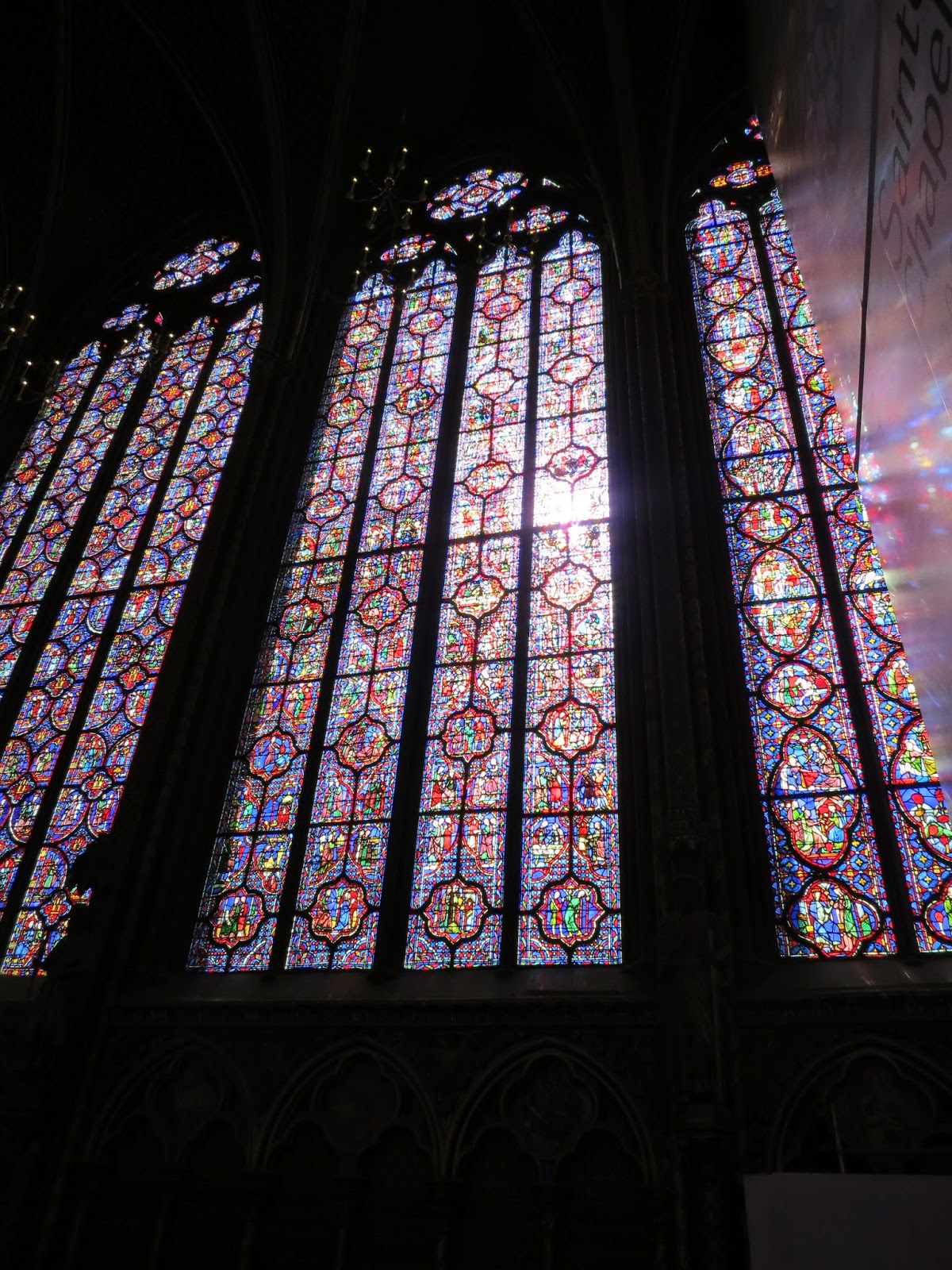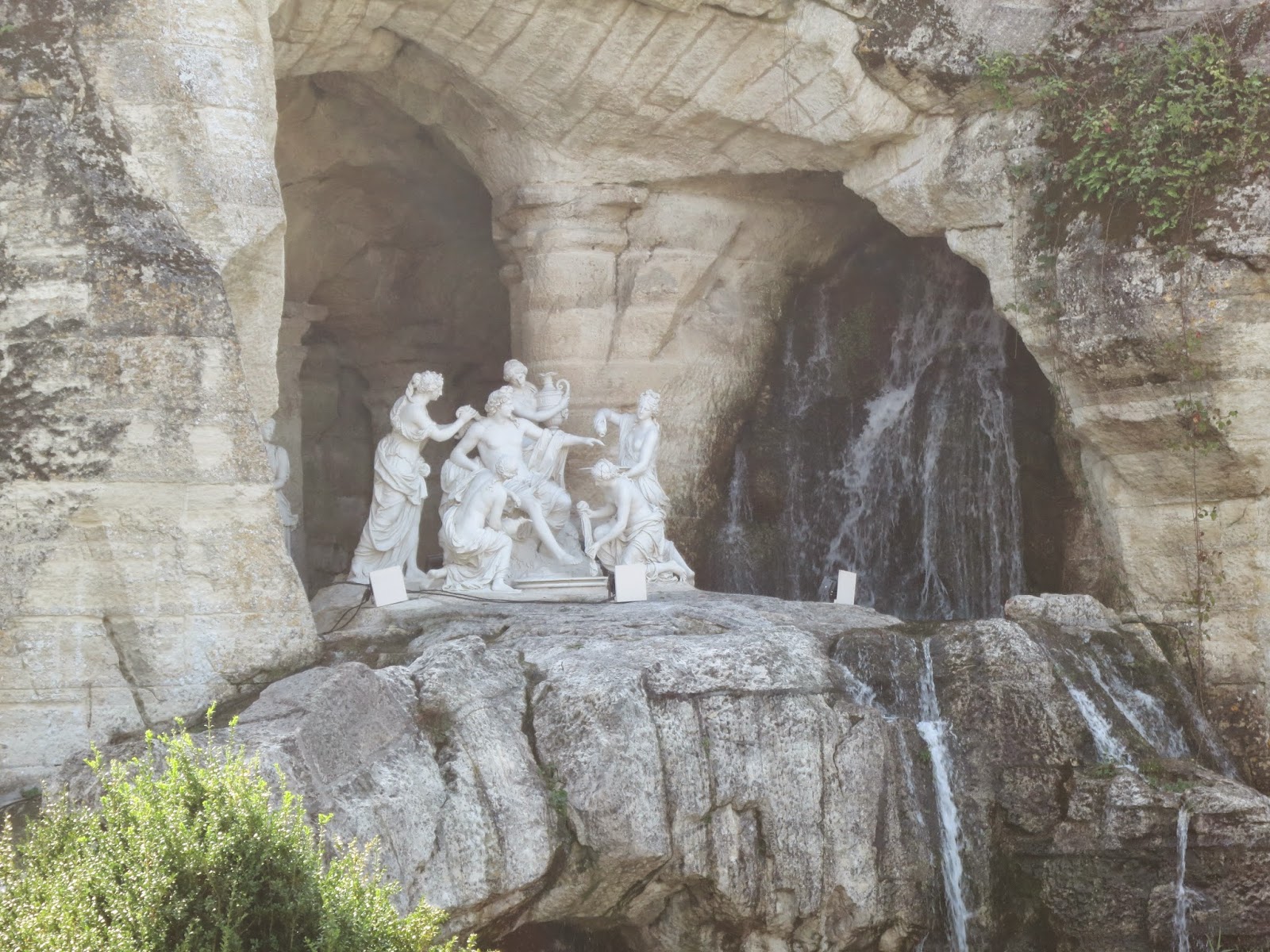Our museum pass had covered the palace, but we had to pay
extra for the fountain show. Normally
the gardens are free, but it was well worth the price of admission. Las Vegas might have the Bellagio, Saint
Petersberg has the palace of Peter the Great, but before both of them there was
one and only spectacle of water in the world:
the Versailles fountains. There
are 55 decorative ponds and fountains, 600 water features and 35 kilometers of
piping spread over 30 hectares. Most of
this is the original plumbing, and all play exactly as they did for the French
Kings. It takes a department of 15
people, 8 of these qualified fountain hydraulic engineers to maintain and
restore the systems year round. (Sorry I
do like these facts as they were presented on a sign.)
 |
| Looking out into the Gardens |
 |
| Map of the Grounds that I found |
The first thing one sees as they step out behind Versailles
is the immensity of the ground before them.
It seems to stretch for miles into the distance, with the cross
formation of the grand canals in the very center. Boats row about the canal, and beyond this on
either side are small forests. It is
essentially a huge park beyond the palace grounds, and inside the grounds are
the actual fixtures and pathways leading to them in intricate, interweaving
ways.
Like inside, the theme is greek gods, goddesses and
mythology. You are surrounded by the
pantheons and their followers, many of whom are whimsical children taken the
forms of fauns, nymphs, angels, imps and other things. In the very center of all the other features
is the God Apollo, resplendent in his gilded gold covering in the middle of a
round basin. He stands in a chariot,
pulled by horses on the back of a sea monster, and seems to rise out of the
murky depths.
Its an impressive feature to start, but once the water gets
to play, it is even moreso. The spray
rises high over and around him, jutting from the mouths of the monsters and the
center of the fountain. It creates a
mist effect, making Apollo seem to rise from the very depths of the ocean. This is the actual intent of the
designers! Before you can even reach
him there is the Latona fountain.
 |
| Latona Fountain basin |
This and the Apollo fountain share a theme of the Sun God,
since Latona is his mother. The
fixtures of Latona’s poor victims are being transformed by Apollo for snubbing
the woman. Most take the form of frogs,
lizards and other things but others are human, or vaguely human, fixed in the
throes of inhuman shaping of their forms.
It’s both grotesque and gripping, Unfortunately Latona was under reconstruction
but the remains of the pipes and the basin alone were impressive enough.
 |
| ONe of the small fountains, this area is known as the avenue of infants |
 |
| Most of the fountains are of mythical creatures depicted when they are young |
I took the time to wander down a colonnade of smaller
fountains leading away from the house and to a large basin way down below. None of the features here were working yet,
but it was still interesting to see. The
pyramid fountain stood at the head of the long walk, and I didn’t find its pot
and tier structure as impressive as the dragon fountain down below.
 |
| Dragon Fountain |
Dragon is the guardian of the largest and
most impressive of the fountains at Versailles:
the Neptune Fountain. Aptly named
for an amazing fountain, bearing the God of the sea at its center, it has the
largest collections of jets, spouts, statues and fixtures beyond all the others.
 |
| Main Structure of the Neptune fountain |
 |
| Another part of the fountain |
Sadly it was not playing when I came. The water pressure used in all these pipes is
tremendous, and the fountain requires the pressure of ALL others to run at the
end of the day. To give you a sense of
size, it took me a good fifteen minutes to walk around the fountain, taking in
each of the fixtures. (Apologies ahead of time, I don't know why these movies are like this.)
 |
| Pyramid fountain flowing |
By this time, I sensed a change in the air and the distant
sound of music. Hurrying up the path, I
found water starting to flow down the structure of the pyramid fountain. I hurried to my parents and we went to see
Apollo’s show. It was very impressive,
but I knew it was only the beginning. My
parents had seen this fountain alone in their trip to Versailles and they never
even knew about many of the others. I’d
done my research, and picked the very best of the best that I felt were worth
visiting while we were there.
 |
| Apollo Fountain at play |
First and most impressive is the Enceladus fountain, which sits
nestled in the center of a small grove of tree’s surrounded by iron
gables. I wanted to get close to take a
picture, but was swiftly shooed away, for good reason as I later found
out. Enceladus was perhaps the most expressive and human of
the big fountains which we saw play. He
rises as a fallen titan, surrounded by rubble.
While the stone around him is black and volcanic, he is gold, frozen in
the throes of his struggle to escape. It
is his face that captures you first, the great, gaping mouth, and eyes staring
to heaven with a look of utter agony.
 |
| Enceladus |
 |
| The giant wakes |
At first I felt disappointed that we would not see the
fountain play, but then, suddenly a strum of music met my ears. A voice, a man’s voice, cried out in agony,
operatic as small burblers of water suddenly came to life around the center
statue. The music and the voice swelled,
seeming to match the face and the voice I could imagine from this pool, trapped
soul. For a moment, there was just the
music and the water, then there was a sound like a deep resonance. The ground physical trembled, rumbled, there
was the sound like a gunshot and suddenly a jet of water erupted from the mouth
of the statue itself! Enceladus had come
alive!


The spray was incredible, and I swiftly backed away as it
started to drift over us. It must have
gone up 50 feet into the air, taller than any other fountain (I would see it
over the hedges later.) This was a first
example of the incredible power harnessed by these fountains. They do not use pumps at all, but natural
water pressure that builds up and builds up.
When the fountain turns on that pressure is released like the cork from
a champagne bottle – lending that sound I heard.
 |
| Waking |
 |
| Full spray |
We stayed for a good while here, and the fountain was
probably the most impressive of all the ones we saw play, but there were plenty
more to come and I had a schedule to keep.
Next on the list was the bath of Apollo, which has the god resplendent
in a cave and tended to by lovely ladies.
He’s resting, you see, from his day in the Apollo fountain, driving his
chariot. His horses are tended one side,
while he ravishes with the bathing beauties.
Water flows down the artificial rock caves, creating a unique grotto
feel that was quite beautiful.
 |
| Apollo fountain at play |
From here we trekked through interwoven grottos and paths
and saw the Colonnade, Ballroom and Mirror fountains.
 |
| Colonnade fountain |
Of the three only the Mirror was working, and was by far
the most whimsical and interactive. The
water here comes out jets that rise or fall, shift and sway, swirl and turn,
all by the pressure naturally exerted in the pipes. It must have taken the original engineers
every last bit of energy to turn on different fixtures at precisely the same
time. The font was playing to a nice
show of music which I will let you enjoy for yourself.
 |
| MIrror Fountain, First show |
There were only four other fountains worth noting, each
marking a distinct fork in the paths that lead to all the rest. The fountains represent four gods and the
four seasons: winter, summer, fall and spring.
We saw spring working, but the rest were silent but still quite
wonderful to see.
 |
| Bacchus Faountain |
It was the image of Bacchus, God of Wine and symbol of Fall
that first got me interested in the fountains of Versailles. He sits in the center, surrounded by fauns
and enjoying the grapes with a pleasant and inebriated expression on his
face. It reminded me once more of the
“Puck” statue back at the Louvre.
 |
| Saturn Fountain |
 |
| Looking back on the palace |
I’d no idea how expansive and exhausting the gardens were,
and I felt so bad for my parents because I dragged them hither and yon to see
every last inch. We took lunch at a
wonderful little café just outside the grounds and on the shore of the
canal. It was here I found a map and
traced our route. We’d covered only a
portion of the garden, and we had no energy to go see the hamlet of Marie
Antoinette or the Trianon Palaces. I had
seen enough to give me fond memories for a lifetime. It was another thing to check off my bucket
list.

























































